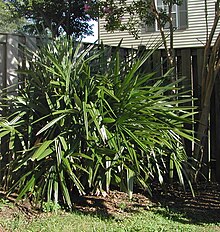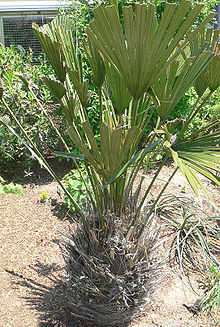
Serenoa repens, commonly known as saw palmetto, is a small palm, growing to a maximum height around 200–300 cm (6.6–9.8 ft).

Aralia spinosa, commonly known as devil's walking stick, is a woody species of plant in the genus Aralia, family Araliaceae, native to eastern North America. The various names refer to the viciously sharp, spiny stems, petioles, and even leaf midribs. It has also been known as Angelica-tree.

Trachycarpus fortunei, the Chinese windmill palm, windmill palm or Chusan palm, is a species of hardy evergreen palm tree in the family Arecaceae, native to parts of China, Japan, Myanmar and India.

Washingtonia is a genus of palms, native to the southwestern United States and northwest Mexico. Both Washingtonia species are commonly cultivated across the Southern United States, the Middle East, southern Europe, and North Africa, where they have greatly hybridized.

Sabal minor, commonly known as the dwarf palmetto, is a small species of palm. It is native to the deep southeastern and south-central United States and northeastern Mexico. It is naturally found in a diversity of habitats, including maritime forests, swamps, floodplains, and occasionally on drier sites. It is often found growing in calcareous marl soil. Sabal minor is one of the most frost and cold tolerant among North American palms.

Washingtonia robusta, known by common name as the Mexican fan palm, Mexican washingtonia, or skyduster is a palm tree native to the Baja California peninsula and a small part of Sonora in northwestern Mexico. Despite its limited native distribution, W. robusta one of the most widely cultivated subtropical palms in the world. It is naturalized in Florida, California, Nevada, Arizona, New Mexico, Hawaii, Texas, parts of the Canary Islands, Spain, Portugal, France, Italy, Malta, Albania, Greece, Turkey, Cyprus, Israel, Palestine, Jordan, Lebanon, Syria, Iraq, Saudi Arabia, Bahrain, Qatar, United Arab Emirates, Oman, Yemen, Iran, Afghanistan, Egypt, Libya, Tunisia, Algeria, Morocco, and Réunion,.

Chamaerops is a genus of flowering plants in the family Arecaceae. It contains only one species, Chamaerops humilis, variously called European fan palm or the Mediterranean dwarf palm. It is one of the most cold-hardy palms and is used in landscaping in temperate climates.

Nannorrhops ritchiana, the Mazari palm, is the sole species in the genus Nannorrhops in the palm family Arecaceae.

Corypha umbraculifera, the talipot palm, is a species of palm native to eastern and southern India and Sri Lanka. It is also grown in Cambodia, Myanmar, Thailand and the Andaman Islands. It is one of the five accepted species in the genus Corypha. It is a flowering plant with the largest inflorescence in the world. It lives up to 60 years before bearing flowers and fruits. It dies shortly after.
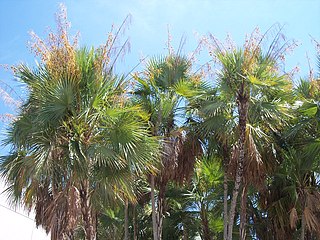
Acoelorrhaphe is a genus of palms with single species Acoelorrhaphe wrightii, known as the Paurotis palm, Everglades palm or Madeira palm in English and cubas, tique, and papta in Spanish.
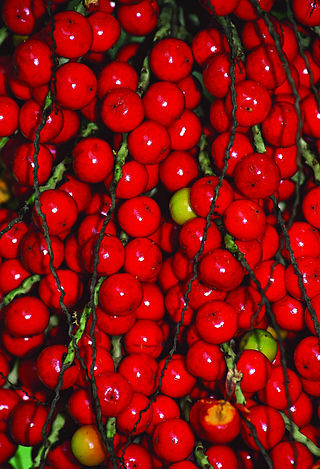
Aiphanes minima is a spiny palm tree which is native to the insular Caribbean from Hispaniola to Grenada, and widely cultivated elsewhere. Usually 5–8 metres (16–26 ft) tall, it sometimes grows as an understorey tree and only 2 m (6.6 ft) in height.

Yucca gloriosa is a species of flowering plant in the family Asparagaceae, native to the southeastern United States. Growing to 2.5 m (8 ft), it is an evergreen shrub. It is widely cultivated as an ornamental for its architectural qualities, and has reportedly become established in warmer climates in the wild in various parts of the world.

Rhapis is a genus of about 10 species of small palms native to southeastern Asia from southern Japan and southern China south to Sumatra. The species are commonly known as lady palms. They are fan palms, with the leaves with a bare petiole terminating in a rounded fan of numerous leaflets. The plants have thin stems growing to 3–4 m tall, branching at the base, forming clumps and are dioecious, with male and female flowers produced on separate plants.
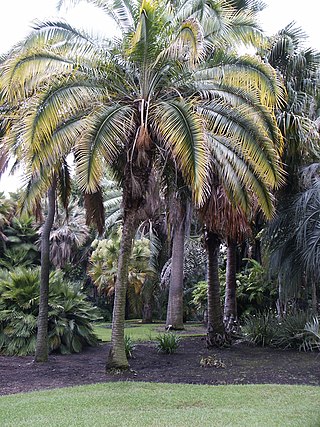
Phoenix rupicola or cliff date palm is a species of flowering plant in the palm family, native to the mountainous forests of India and Bhutan from 300 to 1200 m, usually occurring on cliffs, hillsides and similar terrain. It is threatened by habitat loss in its native range. On the other hand, the species is reportedly naturalised in the Andaman Islands, the Leeward Islands, Cuba and Puerto Rico and a specimen has recently been reported in Saint Lucia.

Roscheria is an endangered, monotypic genus of flowering plant in the palm family. The genus is named for Albrecht Roscher, a 19th-century German explorer, and the epithet for its single species R. melanochaetes derives from Latin and Greek meaning 'black' and 'bristle', alluding to the spines covering the trunks. They naturally occur on the Mahé and Silhouette Islands of Seychelles where they grow in mountainous rainforest and are threatened by habitat loss.
Barcella is a monotypic genus of flowering plant in the palm family found in the States of Amazonas and Roraima in northwestern Brazil. The only known species is Barcella odora which is used by the Brazilian peoples in construction and for various thatched goods.
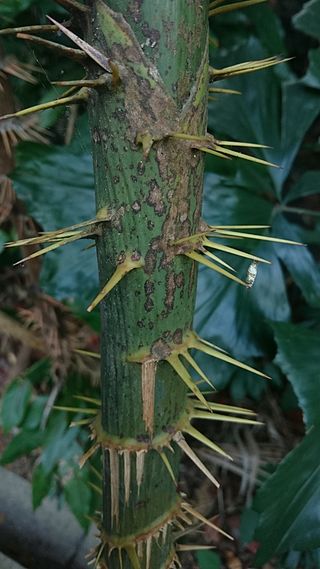
Myrialepis is a monotypic genus of flowering plant in the palm family. The single species, Myrialepis paradoxa, is native to Southeast Asia. The genus name is a combination of the Greek words meaning "innumerable" and "scale", a description of the fruit, and the epithet is Latin for "paradox".

Ptychosperma elegans, commonly known as the solitaire palm, is a very slender palm endemic to Queensland in Australia. In the nursery trade and in the United States it may be confusingly referred to as Alexander palm, which is an often-used but misnomered name of another Australian palm species Archontophoenix alexandrae, the Alexandra palm.

Calamus radicalis, commonly known as vicious hairy mary, is a plant in the palm family Arecaceae endemic to the rainforests of north east Queensland, Australia. Like other species in the genus Calamus, this is a climbing plant with a very long and flexible stem. It uses sharp strong hooks on the fronds and tendrils to attach itself to other vegetation, such as taller established trees, thus gaining support that enables it to grow higher towards the canopy. This species is very similar to C. australis, with which it coexists, but is larger in almost all respects.
